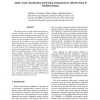Free Online Productivity Tools
i2Speak
i2Symbol
i2OCR
iTex2Img
iWeb2Print
iWeb2Shot
i2Type
iPdf2Split
iPdf2Merge
i2Bopomofo
i2Arabic
i2Style
i2Image
i2PDF
iLatex2Rtf
Sci2ools
ICPR
2010
IEEE
2010
IEEE
Audio-Visual Classification and Fusion of Spontaneous Affective Data in Likelihood Space
This paper focuses on audio-visual (using facial expression, shoulder and audio cues) classification of spontaneous affect, utilising generative models for classification (i) in terms of Maximum Likelihood Classification with the assumption that the generative model structure in the classifier is correct, and (ii) Likelihood Space Classification with the assumption that the generative model structure in the classifier may be incorrect, and therefore, the classification performance can be improved by projecting the results of generative classifiers onto likelihood space, and then using discriminative classifiers. Experiments are conducted by utilising Hidden Markov Models for single cue classification, and 2 and 3-chain coupled Hidden Markov Models for fusing multiple cues and modalities. For discriminative classification, we utilise Support Vector Machines. Results show that Likelihood Space Classification im
Computer Vision | Generative Model | Generative Model Structure | ICPR 2010 | Likelihood Space Classification |
| Added | 12 Feb 2011 |
| Updated | 12 Feb 2011 |
| Type | Journal |
| Year | 2010 |
| Where | ICPR |
| Authors | Mihalis A. Nicolaou, Hatice Gunes, Maja Pantic |
Comments (0)

